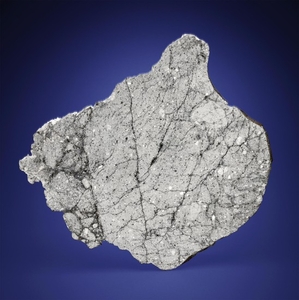Deep Impact: Martian, Lunar and other Rare Meteorites
This complete slice of a Moon rock has a gray matrix. A darker section evidences lunar regolith melt with impact melt veins transecting the specimen. Signature inclusions of anorthite are in evidence, including a notable inclusion.
105 x 109 x 2 mm. (4 x 4¼ x ⅛ in.) and 38.39 g.
Rocks from the Moon are among the rarest substances on Earth, and now offered is a complete slice of one such rock that was blasted off the lunar surface following an asteroid impact. There are less than 350 kilograms of lunar meteorites known to exist and a significant fraction is controlled by governmental institutions. Moon rocks are identified by specific textural, mineralogical, chemical and isotopic signatures. Many of the common minerals found on Earth’s surface are rare on the Moon and some lunar minerals are unknown on Earth. In addition, Moon rocks contain gases captured from the solar wind with isotope ratios very different from the same gases found on Earth. While Apollo astronauts returned with 382 kg. of Moon rocks, not one milligram is available for private ownership. The amount of the Moon that is not governmentally controlled and available to the private sector might fill a single footlocker. NWA 8022, is the 8,022nd rock recovered in the North West African grid of the Sahara Desert to be analyzed and classified. The single 1.2 -kilogram stone from which this slice is derived is a highly-recrystallized breccia composed mainly of very fine-grained minerals and a few much larger grains of anorthite (a calcium-aluminum silicate mineral whose presence is a signature of most Moon rocks). Shock veins transect the specimen. This lunar sample was classified by Dr. Anthony Irving, one of the world’s foremost classifiers of planetary material.
The official classification of this lunar meteorite appears in the 102nd edition of the Meteoritical Bulletin. The write-up was done by the world’s most renowned classifier of lunar meteorites, Dr. Anthony Irving, and a copy of the abstract and the write-up accompanies this offering
Christie's would like to thank Dr. Alan E. Rubin at the Institute of Geophysics and Planetary Physics, University of California, Los Angeles for his assistance in preparing this catalog note.
View it on
Estimate
Time
Auction House
This complete slice of a Moon rock has a gray matrix. A darker section evidences lunar regolith melt with impact melt veins transecting the specimen. Signature inclusions of anorthite are in evidence, including a notable inclusion.
105 x 109 x 2 mm. (4 x 4¼ x ⅛ in.) and 38.39 g.
Rocks from the Moon are among the rarest substances on Earth, and now offered is a complete slice of one such rock that was blasted off the lunar surface following an asteroid impact. There are less than 350 kilograms of lunar meteorites known to exist and a significant fraction is controlled by governmental institutions. Moon rocks are identified by specific textural, mineralogical, chemical and isotopic signatures. Many of the common minerals found on Earth’s surface are rare on the Moon and some lunar minerals are unknown on Earth. In addition, Moon rocks contain gases captured from the solar wind with isotope ratios very different from the same gases found on Earth. While Apollo astronauts returned with 382 kg. of Moon rocks, not one milligram is available for private ownership. The amount of the Moon that is not governmentally controlled and available to the private sector might fill a single footlocker. NWA 8022, is the 8,022nd rock recovered in the North West African grid of the Sahara Desert to be analyzed and classified. The single 1.2 -kilogram stone from which this slice is derived is a highly-recrystallized breccia composed mainly of very fine-grained minerals and a few much larger grains of anorthite (a calcium-aluminum silicate mineral whose presence is a signature of most Moon rocks). Shock veins transect the specimen. This lunar sample was classified by Dr. Anthony Irving, one of the world’s foremost classifiers of planetary material.
The official classification of this lunar meteorite appears in the 102nd edition of the Meteoritical Bulletin. The write-up was done by the world’s most renowned classifier of lunar meteorites, Dr. Anthony Irving, and a copy of the abstract and the write-up accompanies this offering
Christie's would like to thank Dr. Alan E. Rubin at the Institute of Geophysics and Planetary Physics, University of California, Los Angeles for his assistance in preparing this catalog note.



